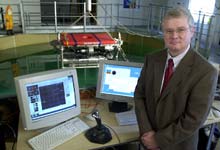New software that responds to written questions by retrieving digital images has potentially broad application, ranging from helping radiologists compare mammograms to streamlining museum curators’ archiving of artwork, say the Penn State researchers who developed the technology.
Dr. James Z. Wang, assistant professor in Penn State’s School of Information Sciences and Technology and principal investigator, says the Automatic Linguistic Indexing of Pictures (ALIP) system first build
A new model of mid-ocean ridge propagation: Introducing the process zone
The site of extensive volcanic activity and sea-floor spreading, the Galapagos Rise in the eastern equatorial Pacific Ocean has yielded groundbreaking research results for the field of plate tectonics. Jacqueline Floyd and her colleagues, all of Columbia University’s Lamont-Doherty Earth Observatory, are introducing a new model for the process of mid-ocean ridge propagation (lengthening), which is responsibl
A NASA study finds that perennial sea ice in the Arctic is melting faster than previously thought–at a rate of 9 percent per decade. If these melting rates continue for a few more decades, the perennial sea ice will likely disappear entirely within this century, due to rising temperatures and interactions between ice, ocean and the atmosphere that accelerate the melting process.
Perennial sea ice floats in the polar oceans and remains at the end of the summer, when the ice cover is at its
The first outbreak of the evolution of multicellular organisms falls on the Wend, the last period of the Proterozoic (Precambrian), about 620-550 million years ago. At that time, climate of our planet was rather cold, and glaciers that covered the single supercontinent nearly reached the equator. The cold is beneficial for the evolution of sea creatures.
In modern seas, significant concentrations of dissolved oxygen, phosphates, and the organic matter provide for a high biological productiv

Tethered Robotic Sub Helps Engineers Refine Computerized Navigation, Control Systems
In a new indoor tank filled with almost 43,000 gallons of water, Johns Hopkins engineers are developing and testing computer control systems to serve as the “brains” for some of the world’s leading deep sea robotic exploration vehicles. To promote advances in underwater robotics, the Whiting School of Engineering recently constructed the circular hydrodynamics tank, 14 feet deep and 25 feet in diamet
Oil from the wrecked tanker off the northwest coast of Spain had already reached the Spanish coast when ESA’s Envisat satellite acquired this radar image of the oil slick, stretching more than 150 km, on Sunday, 17 November, at 10.45 UTC.
The 26-year-old tanker, Prestige, can be seen as a bright white point located about 100 km off the coast. Support vessels are identifiable as smaller white points surrounding the ship. The huge oil slick is clearly visible as a dark plume emanating from the